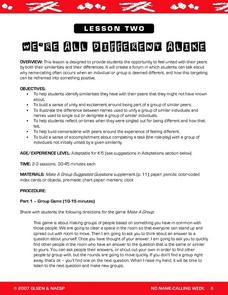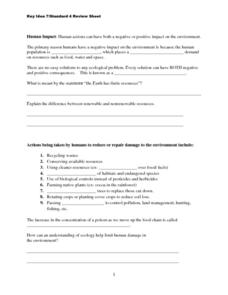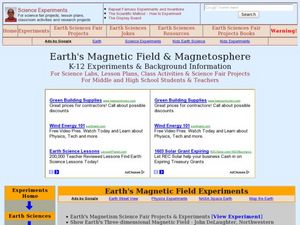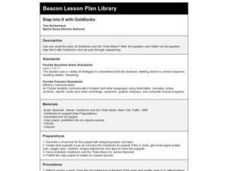Curated OER
What Shape is the Moon Tonight?
Students understand that the moon appears differently throughout the month. In this phases of the moon lesson, students observe and record the phases of the moon.
Curated OER
Voyage to Kure Viewing Guide
Students complete a worksheet while viewing a video about the oceans. They locate the oceans on a map and identify positive and negative ways in which humans have impacted them. They discuss any questions at the end of the lesson.
Curated OER
Wilderness Survival: A Field Practicum
Students are provided with hands-on-field testing of authentic applications from principles pertaining to: Psychology A. Develop a positive, can-do attitude with a high degree of self-reliance that is transferable to human interactions...
Curated OER
Wilderness Survival: A Field Practicum
High schoolers use hands-on field-testing of authentic application from principles pertaining to: Psychology- A. Develop a positive, can-do attitude with a high degree of self-reliance that is transferable to human interactions outside...
Curated OER
IUPAC Rules for Naming Compounds with Functional Groups
In this naming compounds with functional groups worksheet, learners read about using the IUPAC rules for naming these compounds and they draw structures for 3 -carbon, 2-carbon and 4-carbon molecules and give the names for each.
Curated OER
Balloon Rockets
Students, after reviewing and analyzing Newton's third law of motion, make balloon rockets and experiment with a variety of models. After the experiment, they chart the results and form conclusions. In addition, they compare/contrast...
Curated OER
How Do Astronomers Measure Distances to Stars?
In this astronomy worksheet, students participate in an activity using the parallax effect to measure star distances. They record their information in a data table then complete 5 fill in the blank conclusion questions.
Curated OER
2-Minute Hockey Challenge
Students demonstrate controlled dribbling within a restricted space.
Curated OER
Runaway Greenhouse Effect Exercise
Students role-play biologists, coal geologists, space warfare experts, astronomers, pollution-control scientists, and hydrophysicists as they answer the question, "Why is Venus so much hotter than the Earth?"
Curated OER
We're all different alike?
Learners identify similarities and differences that they have with their peers. They explore why name-calling often occurs when an individual or group is deemed different, and how this targeting can be reframed into something positive
Curated OER
Water: The Neutral Substance
In this water learning exercise, students read about hydrogen bonds in water and the differences in electronegativity between the oxygen atom and the two hydrogen atoms in water. Students answer four questions about the structure of...
Curated OER
Standard 4 Review-Human Impact
In this human impact on the environment worksheet, high schoolers fill in the blanks to complete sentences about how humans have negatively affected the environment. They complete sentences about the actions taken to reduce and repair...
Curated OER
Ups and Downs of Diving
Students explore the science and sport of scuba diving. For this scuba diving lesson, students build Cartesian divers and observe their behavior under water pressure.
Curated OER
Student Exploration: Summer and Winter
In this recognizing the seasons online/interactive activity, students explore the Earth's positions and determine the summer and winter season. Students answer 21 short answer questions
Curated OER
Resolving Kennedy's Legacy
Young scholars examine the Kennedy presidency. In this presidential history lesson, students watch "Resolving Kennedy's Legacy." Young scholars then discuss the provided questions regarding the presidency and write position papers about...
Curated OER
Interesting Integers
Middle schoolers add and subtract integers. In this algebra lesson, students analyze integers using hands on manipulative. They solve problems of addition and subtractions using their signs correctly. They play a game of cards to...
Curated OER
Time Line of Astronomy Events and Discoveries
Students work in groups to present a segment of a timeline of events and discoveries in astronomy. In this astronomy lesson plan, students teach their classmates about their section of the timeline.
Curated OER
The MPA “GamePlan”
Eighth graders explore the purpose of having Marine Protected Areas. In this environmental science lesson, 8th graders simulate the planning process by playing a board game. They explain the positive and negative effects of trade offs.
Curated OER
Earth's Magnetic Field and Magnetosphere
Students investigate the magnitude of Earth's magnetic field using PASCO. In this physics lesson, students describe the features of the magnetosphere. They explain how atmosphere layers protect the Earth.
Curated OER
Place Value Charts to the Millions Place
In this math worksheet, students learn to read, write, order and compare numbers and place them on a place value chart. Students begin the 4 pages of exercises by studying a sample place value chart. Students then fill out 3 other charts...
Curated OER
Trigonometric Functions
In this trigonometric functions instructional activity, students solve and complete 35 various type of problems. First, they find the values for all six trig functions that pass through the given points. Then, students prove different...
Curated OER
Power Functions: A Question of Magnitude
For this power functions worksheet, students read about determining the brightness of stars using a magnitude scale. Students solve 4 problems including finding the magnitude differences of stars and determining equivalent magnitudes.
Curated OER
Making Art That Matters
Young scholars plan and execute a mural, in small groups, that attempts to protest or persuade. They focus on effective definition of shape, use of symbols, and impact on their intended viewers.
Curated OER
STEP INTO IT WITH GOLDILOCKS
First graders use sequencing to recall and tell the story of Goldilocks and the Three Bears. They create a storyboard using pencils first and then crayons with six illustrations in sequence.























